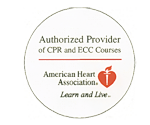Symptoms of an acute asthma attack include:
- Difficulty breathing, shortness of breath, or very rapid breathing
- Severe wheezing when breathing both in and out
- Coughing that won’t stop
- Chest pain or pressure
- Tightened neck and chest muscles, called retractions
- Difficulty talking and performing normal daily activities
- Feelings of anxiety or panic
- Pale, sweaty face
- Blue lips or fingernails
- Worsening symptoms despite use of your medications
First Aid Steps for Acute Asthma Attack:
1. Follow the personalized asthma plan for the individual if possible. Check to see that they have proper medication.
2. If they don’t have an asthma plan:
- Sit the person upright and loosen tight clothing.
- If he/she has an inhaler, assist them in using it.
- If he/she doesn’t have an inhaler, use one from a first aid kit or borrow one.
3. Using an Inhaler:
- Remove cap and shake inhaler well.
- Insert inhaler into spacer.
- Have the person breathe out completely and put mouth tightly around spacer mouthpiece.
- Press inhaler once to deliver a puff.
- Have the person breathe in slowly through the mouth and then hold breath for 10 seconds.
- Give a total of four puffs, waiting about a minute between each puff.
4. If the inhaler with spacer doesn’t work, use the inhaler without a spacer as such:
- Remove the inhaler cap and shake well.
- Have the person breathe out all the way and seal lips tightly around inhaler mouthpiece.
- As the person starts to breathe in slowly, press down on inhaler one time.
- The person should keep breathing in as slowly and deeply as possible (about five to seven seconds) and then hold breath for 10 seconds.
- Give a total of four puffs, waiting about one minute between each puff.
5. Continue to use the inhaler.
- After four puffs, wait four minutes. If the person still has trouble breathing, give another set of four puffs.
- If there’s still little or no improvement, give four puffs every four minutes until ambulance arrives. If the person is having a severe attack, give up to six to eight puffs every five minutes.
6. Should the need arise, check to see if the person needs CPR. If you don’t know CPR, give hands-only CPR.
7. Monitor the Person Until Help Arrives
- Do not mistake drowsiness as a sign of improvement; it could mean asthma is worsening.
- Do not assume the person’s asthma is improving if you no longer hear wheezing.





